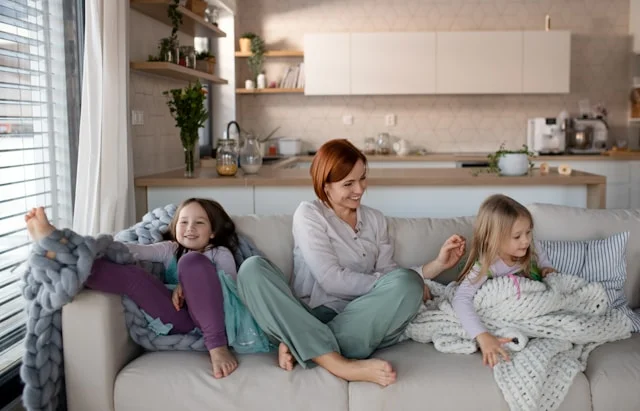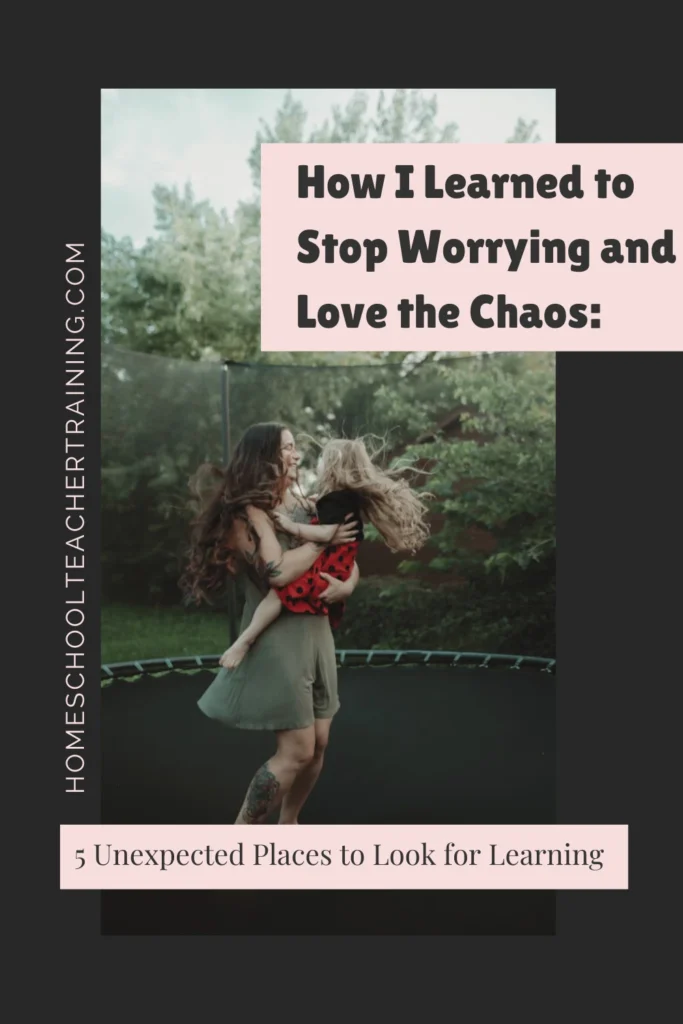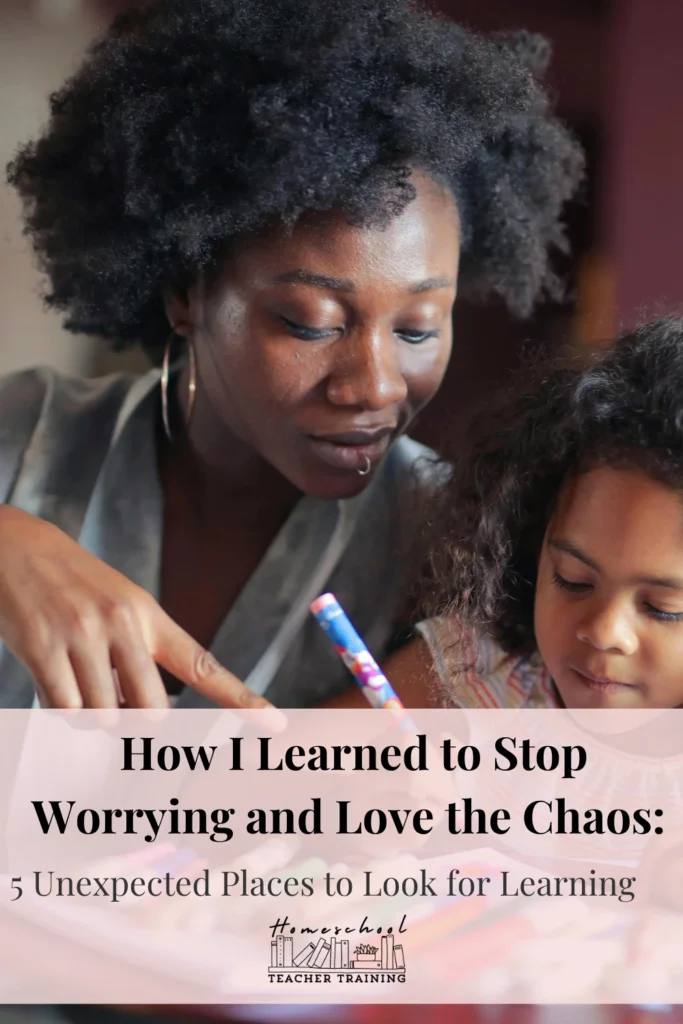How I Learned to Stop Worrying and Love the Chaos: 5 Unexpected Places to Look for Learning
I used to worry constantly about whether my kids were learning “enough.” Maybe you’ve had that worry too – especially on days when your living room looks like a hurricane hit it and your kids seem more interested in Minecraft than math.
Here’s what changed everything for me: I learned to look for learning in unexpected places. Once I cleared away my assumptions about what education should look like, I started seeing rich learning opportunities everywhere – not just in textbooks and worksheets, but in the everyday chaos of childhood.
Let me show you five surprising places where natural learning at home might be hiding in plain sight. Better yet, I’ll share what I’ve learned from watching my own kids discover the world in their own unique ways.

Table of Contents
1. The Surprising World of Video Games
“But shouldn’t we be stricter about screen time?” This is one of the most common questions other parents bring to me. There’s often a worry that video games are somehow inherently harmful, that children should be doing “something better” with their free time.
Finding the Right Balance
I understand this concern – we all want what’s best for our kids. But I’ve found that the reality of gaming and learning is far more nuanced than simple “screen time” debates suggest.
Yes, some limits are often necessary. Every family and every child will need different boundaries. For instance, when my daughter was younger, she struggled with transitioning away from screens when we needed to do other things. We learned to keep her gaming sessions shorter and build in extra transition time before meals, bedtime, or going out. My son, on the other hand, has always been able to put games away easily when asked. The key is paying attention to your individual child’s needs and adjusting accordingly.
And yes, you might need to set content limits too. While it hasn’t been an issue in our family yet, I would certainly step in if my kids started showing interest in games with inappropriate violence or other concerning content.
The Hidden Learning in Gaming
But beyond these practical boundaries, I’ve learned not to view gaming time as “wasted” time. When I watch with curiosity, I see rich and unexpected learning happening:
- Problem-solving: Games constantly present new challenges that require creative solutions
- Reading comprehension: From quest instructions to crafting recipes, games are full of text that kids are motivated to understand
- Strategic thinking: Whether managing resources in Minecraft or planning moves in chess games, players have to think several steps ahead
- Persistence: Games provide a safe place to fail, try again, and learn from mistakes
- Social skills: Many games involve collaboration, communication, and navigating social dynamics with other players
- Systems thinking: Games help kids understand how different parts interact and affect each other
Beyond the Game: Sparking Deeper Interests
Even more importantly, games can spark interests that lead to deeper learning. I’ve seen kids:
- Learn to read gaming wikis and strategy guides
- Join online communities to share tips and creations
- Get interested in coding to mod their favorite games
- Create art and stories inspired by games
- Learn about history through historically-based games
- Practice a second language to play with international friends
The key isn’t to pretend all gaming is educational or that limits aren’t sometimes needed. Instead, it’s about shifting our perspective to see the unexpected learning opportunities that exist within gaming, while still being mindful of finding the right balance for our individual children and families.

2. Popular Books and Media
“My son only wants to read Dog Man books,” I told another mom recently. “And my daughter watches High School Musical on repeat.” I wasn’t really worried – I was just sharing what my kids were into. But she was concerned about her own kids’ similar interests. “Shouldn’t we push them toward better quality books and shows?” she asked.
I get it. During our formal learning time, we absolutely read the best literature we can find. We dive into beautiful language, compelling stories, and big ideas. But I’ve learned something important about all those other hours in the day: when we learn to see the value in what our children naturally choose, we can support their growth more effectively.
When my kids read Dog Man, they’re building reading confidence, picking up on story patterns, and processing complex ideas through seemingly simple stories. The artwork helps them develop visual literacy skills, and the humor gives them new vocabulary in context. Most importantly, they’re learning to love reading.
The same goes for shows like High School Musical. What looks like just entertainment often leads to deeper engagement. My daughter:
- Creates her own songs and dance routines
- Writes stories about the characters
- Acts out scenes with friends
- Has thoughtful discussions about characters’ choices
Here’s what I’ve learned: We can be intentional about the literature we choose for learning time while still letting our kids enjoy popular books and media in their free time. After all, I love reading George Eliot, but I also enjoy the occasional reality TV binge. Having a rich diet of quality literature gives me the freedom to enjoy simpler entertainment without worry – and the same is true for our kids.

3. When Every Conversation is a Joke (Literally)
My 12-year-old went through a phase where every conversation was an opportunity for a “dad joke.” And then both kids discovered spoonerisms – you know, switching the first sounds of words around. For an entire week, I heard nothing but “Can I have a bowl of krise rispies?” and variations on the same theme. By day three, I was starting to lose my mind.
But here’s what fascinates me about these seemingly endless word games: they show just how naturally children develop sophisticated language skills. Think about what it takes to understand or create a spoonerism – you have to break words down into individual sounds, swap them around, and understand why the new combination is funny. That’s complex phonetic awareness happening right there, completely driven by their own interest.
What’s Really Happening in Word Play
When kids get obsessed with wordplay, they’re actually building several key language skills:
- Sound awareness and manipulation
- Understanding of multiple word meanings
- Recognition of language patterns
- Social awareness of when humor works (and when it doesn’t)
- Confidence in experimenting with language
The same goes for those groan-worthy dad jokes. To get why “What do you call a fake noodle? An impasta!” is funny, you need to understand multiple meanings, cultural references, and sound patterns. When kids practice telling these jokes over and over, they’re actually building crucial language skills – even if they’re driving us slightly crazy in the process.
I’ve learned to see these phases as signs that my kids are leveling up their language abilities. They’re literally playing with the building blocks of communication, figuring out how words work by taking them apart and putting them back together in new ways. Yes, it can get annoying. But it’s also a sign that unexpected learning is happening.
Does this mean we have to laugh at every joke or participate in endless wordplay sessions? Absolutely not. But we can appreciate what this kind of language play represents: our children’s growing mastery of communication, one terrible pun at a time.

4. Moving to Learn
“Sit still and focus!” That’s what we often think kids need to do to learn effectively. In fact, long-time homeschooling parents know that meeting a child’s need for movement is one of the best ways to help them learn.
I have one child who has always learn best when she’s free to move around a bit. Now, at 9 years old, one of her favourite things to do is wear her Heelys around the house all day. She actually focuses better when she can take quick breaks to roll around the kitchen on her Heelys between problems.
At first, this kind of movement can look like distraction or avoidance. But when you watch closely, you start to see something different happening. That quick wheely break isn’t just burning energy – it’s giving her brain the movement it needs to process and reset.
Creating Space for Active Learning
When my kids were younger, one of their favorite study spots was inside couch cushion forts they’d built themselves. The physical work of construction would engage their bodies, and then somehow, the unique space they’d created became the perfect spot to focus on their work. It was like the movement and creativity of fort-building prepared their brains for learning.
What looks like “just playing” or “being distracted” often turns out to be our children’s natural way of:
- Processing new information
- Regulating their attention
- Developing spatial awareness
- Building physical confidence
- Creating environments that work for their learning style
Of course, we can’t have Heely races through the house all day or rebuild couch forts every hour. But I’ve learned to see movement as part of natural learning at home rather than a distraction from it. Sometimes the child who seems unable to sit still isn’t being defiant – their body might be telling them exactly what they need for learning right now.
The trick is finding ways to support this physical learning while maintaining some household order. In our home, that means having flexible spaces where movement is okay, understanding that quick movement breaks can actually improve focus, and trusting that our kids often know what their bodies need to learn effectively.

When Experimentation Looks Like Waste
“It’s not a waste, it’s a use.” This has become one of my favourite parenting mantras. Of course, I don’t let my kids thoughtlessly waste materials – we all need to learn to be mindful of our resources. But I’ve learned to see the difference between waste and purposeful experimentation.
The Kitchen Laboratory
Take my son’s “potion-making” phase in the kitchen. Instead of seeing it as wasting perfectly good ingredients, I started giving him expired spices and condiments that would have been thrown away anyway. He never wanted to eat his concoctions (thankfully!) – he just wanted to experiment with mixing and observing reactions. That’s not waste; that’s sensory play and even early chemistry.
Food exploration goes beyond just mixing experiments. Did you know children typically need to encounter a new food seven times or more at regular meals before their brains accept it as “normal”? Those small, uneaten portions aren’t waste – they’re essential steps in developing healthy eating habits.
Creative Supply Solutions
Art and craft supplies can be another tricky area. My kids go through materials quickly when they’re inspired, but I’ve found ways to support their creativity without breaking the bank:
- Amazon boxes and egg cartons become building materials
- Scrap printer paper becomes drawing paper
- Dollar store supplies like popsicle sticks and pipe cleaners stock our craft cabinet
- Those big rolls of easel paper from IKEA last forever and cost very little
Even apparent “waste” becomes useful with a bit of creativity – paper scraps transform into confetti for art projects, and fabric remnants become stuffing for pillows. When you start looking for these opportunities, you’ll find them everywhere.
The key is finding ways to support experimentation while teaching responsible use of materials. When we can see the unexpected learning value in what looks like waste, we can make better decisions about when to provide free reign and when to set limits. After all, real learning often gets messy – our job is to make space for that mess without losing our minds (or our budget) in the process.
Look for Learning in the Chaos
When we clear away our preconceptions about what learning “should” look like, we start seeing it everywhere. From Minecraft sessions to potion-making experiments, from endless dad jokes to couch cushion forts – natural learning at home happens in the beautiful chaos of childhood.
This doesn’t mean we abandon all structure or limits. Instead, it means we can set necessary boundaries with confidence, knowing that learning takes many forms. We can trust our children’s natural development while still guiding them toward quality experiences. Most importantly, we can find unexpected learning opportunities in places we might have missed before.
The next time you catch yourself worrying about whether your kids are learning “enough,” try shifting your perspective. Look for learning in the everyday moments, the silly jokes, the messy experiments, and yes, even the video games. You might be surprised by what you discover.











2 Comments